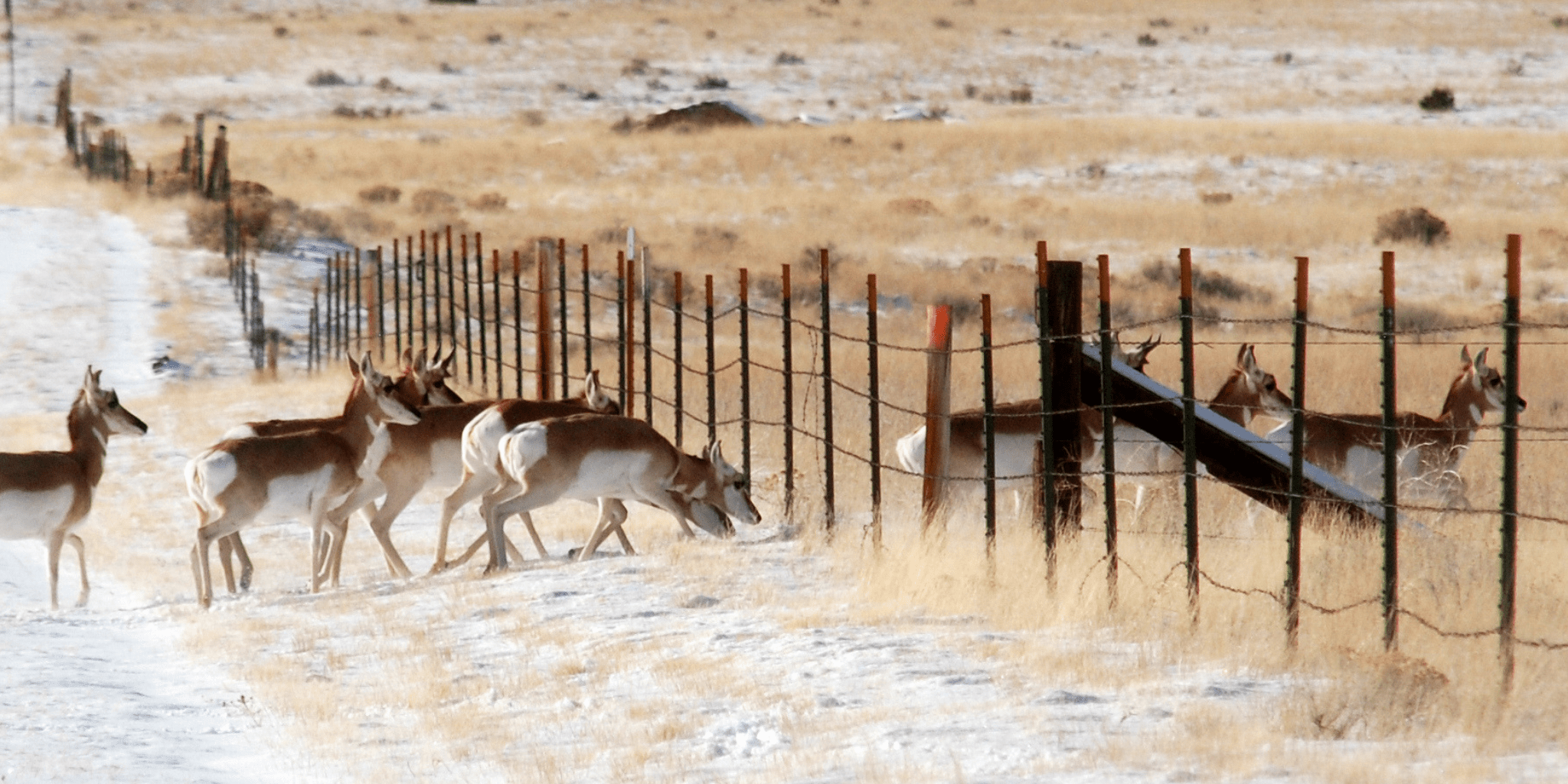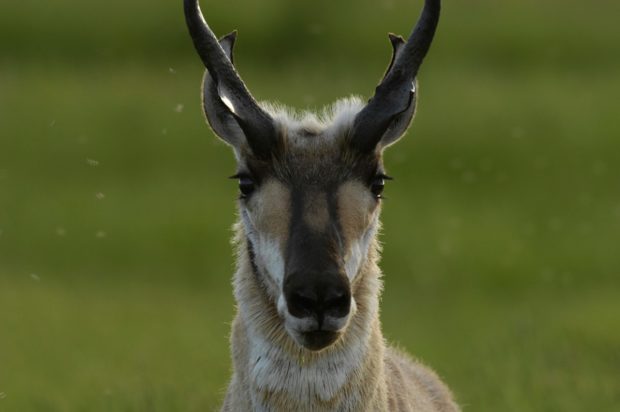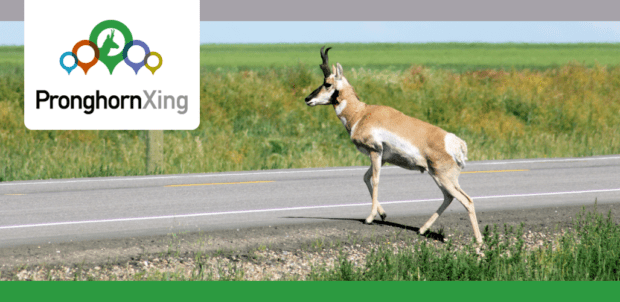We have much more to do and your continued support is needed now more than ever.
Pronghorn Xing: a Two-Pronged Approach

Vehicle collisions, especially in Montana, have become an accepted part of the lifestyle of living in the West. It’s doubtful one could meet a person anywhere here that doesn’t have a personal story about hitting a deer, elk, sheep, or other wildlife. In 2018, Montana ranked second across the United States for a driver’s likelihood in a vehicle collision with a deer with over 14,000 cases filed by Montana drivers. Every year, too many deaths occur as a result of vehicle and wildlife collisions. In 2008, a national wildlife-vehicle collision reduction study found that wildlife vehicle collisions cost $6-12 billion in taxpayer dollars a year, not to mention the toll they take on wildlife.
However, cars and trucks aren’t the only vehicles facing wildlife collisions. For example, in early 2011 along the Montana “Hi-Line,” approximately 1200 animals were killed by trains, including groups of approximately 240 and 270 pronghorn. In addition to the tremendous need to protect wildlife from human-caused harm, the frequency of the loss of human life is worth asking, “What can I do?”
Involving communities in conservation decision making isn’t new or unique. Remember, birders have been counting little brown birds since Frank M. Chapman from the Audubon Society made it cool back in 1900. The Christmas Bird Count, conducted by non-experts, provides vast amounts of data showing where and when birds migrate. In another example, migrating monarch butterflies that overwinter in Mexico have been counted, photographed, and even tagged since the mid 1970s to keep an eye on their visually stunning and impressive lifecycle. But here’s your fun fact for the day, folks: Birds and insects aren’t the only massive migrators in North America.

Allow us to introduce the Pronghorn (Antilocapra americana). Thought of as the red-headed step-child of the ungulate world and typically referred to as an “antelope” or a “speed goat,” it is neither antelope nor goat, nor should they be dismissed. Pronghorn have been on this continent since the Pleistocene Era and, thanks to incredible adaptations, made it through the last Ice Age.
Pronghorn are a taxonomical anomaly – say that three times fast – in that their closest living relative is the giraffe. They are the fastest animal in North America, sprinting up to 60 mph, and retaining speeds of 45 mph for several miles. They can also run 30 mph indefinitely and have enormous eyes to detect predators from a distance. Because they are highly adapted to running rapidly across open plains and grasslands, they’re not great at navigating our roads and fences. In one study, authors showed that in western North America, there were six times as many fences as roads. Fences and roads impede movement, acting as barriers, and can cause animals to be killed through collisions, while also reducing their access to important seasonal ranges. This means that, to lower the number of wildlife-vehicle collisions in Montana, hot spots where pronghorn and other wildlife prefer to cross need to be observed, reported, and understood.
Which brings us to “what can I do?” Pronghorn Xing is a community-science based approach to support wildlife-transportation decisions and increase community engagement across the Hi-Line of Montana. The Pronghorn Xing smartphone application uses free technology and on-line mapping tools to collect data efficiently and accurately where people spot pronghorn or other wildlife on or near roads. Just turn on the app, start a route, and every time you see pronghorn, elk, or deer, tap the button. Data collection on both dead and living animals is needed and valuable and can be used to inform future analyses and recommendations to improve wildlife movement for both human and wildlife safety.

This is where community-science (formerly citizen-science) comes into play. Community-science is becoming more and more accepted as a means to collect data at the scale required to inform decision makers. In particular for making decisions for wildlife, using community-science is a powerful method through empowerment and multi-generational education of local folks.
Ideally, this is a two-pronged approach. First, Pronghorn Xing provides state agencies such as the Montana Department of Transportation and Montana Fish, Wildlife & Parks with wildlife-transportation data, using a standardized process, for use in their decision-making process. Secondly, Pronghorn Xing increases community awareness and engagement through volunteer recruitment, community presentations, and building a ‘wildlife movement’ curriculum, culminating in training local middle and high school students to use the Pronghorn Xing application. By incorporating the Pronghorn Xing app as well as providing activities linked from existing curriculum aligned with the Next Generation Science Standards, students will be able to download observations, track class progress, perform various analyses, and ultimately, instill awareness and pride of being part of a larger decision-making effort.

Pronghorn Xing is a collaborative project to support state agencies, rural communities, and to improve wildlife connectivity. Thus far, the National Wildlife Federation has partnered with the Miistakis Institute in Calgary, Alberta to bring this successful and vetted program into Montana. This community based approach engages rural communities by training volunteers and middle and high school students with innovative data collection technologies as a means to support agency wildlife-transportation mitigation efforts. The Federation believes that this program is a suitable and convenient solution to help reduce vehicle collisions while also raising awareness of and support of wildlife needs across the state. These objectives are consistent with the desired outcomes of the recent Montana Wildlife and Transportation Summit.
Although Pronghorn Xing currently is specific to the Hi-Line, the smartphone application and website are useful resources that are transferable to other areas and suitable for other wildlife. The classroom project, which empowers and educates communities, was piloted in Phillips County, with additional interest from other schools in Havre, Harlem, Chinook, Plentywood, and Lewistown. Not to mention, personnel within state and federal agencies and NGOs have started using and promoting the tool.
If your school is interested in participating, please reach out to Naomi Alhadeff, Montana Education Coordinator, alhadeffn@nwf.org or Andrew Jakes, Wildlife Biologist, jakesa@nwf.org to get involved. This should be an issue near and dear to all Montanans so download today and start to be a part of the management process!
Get the App!
_____
The National Wildlife Federation looks to grow community awareness and engagement by working with local organizations and community members to recruit and train volunteers on Pronghorn Xing through a) community workshops/presentations and b) building an interactive curriculum with high school science classes. Workshops and presentations will showcase the smartphone app and train interested individuals and groups on data collection techniques. Additionally, schools will utilize NWF’s Eco-Schools USA website and its unique Seven Step Framework, allowing students to think creatively and critically about environmental challenges and develop place-based solutions. By incorporating the Pronghorn Xing app as well as providing activities linked from existing curriculum, students will be able to download observations, track class progress, perform various analyses and ultimately, instill awareness and pride of being part of a larger effort.





















